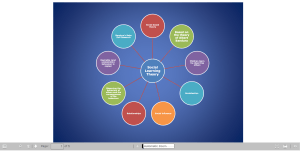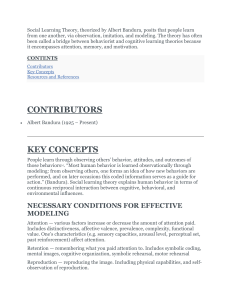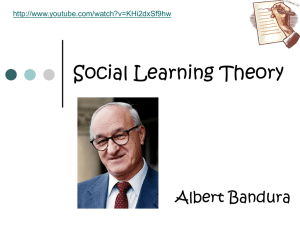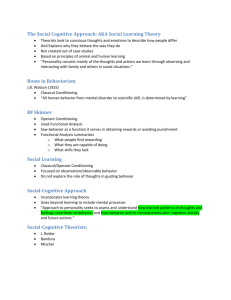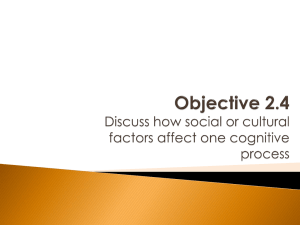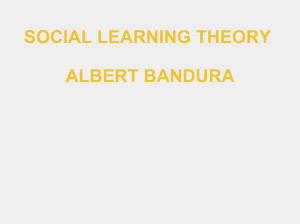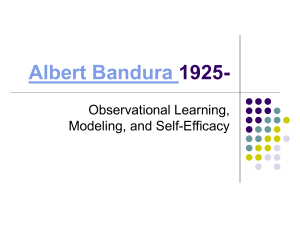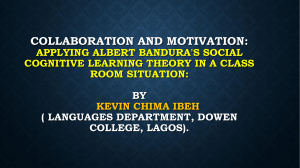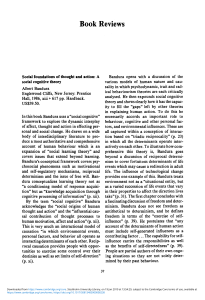Social Learning Theory: Bandura's Concepts & Applications
advertisement
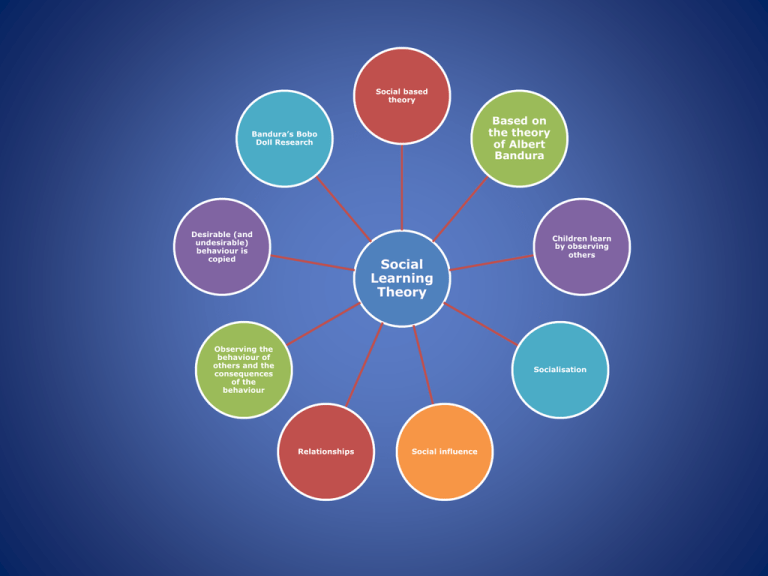
Social based theory Based on the theory of Albert Bandura Bandura’s Bobo Doll Research Desirable (and undesirable) behaviour is copied Social Learning Theory Observing the behaviour of others and the consequences of the behaviour Children learn by observing others Socialisation Relationships Social influence Social Learning theory • Social learning theory is based upon the work of Albert Bandura. It is also referred to as Social Cognitive Theory (SCT) • This theory attempts to understand the process that is involved in explaining how we learn from each other • It focuses on learning that occurs by direct experience by observing, imitating, and modeling • It provides a framework for understanding, predicting and potentially changing human behaviour. • Aspects of Bandura’s theory are that: o children learn by observing others, o the same set of stimuli may provoke different responses from different people, or from the same people at different times o the environment and a person’s behaviour are interlinked; o personality is an interaction between three factors: the environment, behaviour, and a person’s psychological processes. All 3 play an important role in the learning process. They are constantly influencing each other Environmental factors would include Social aspects - peers, family and teachers and Physical factors - the layout or size of the class room or the temperature of the room Implications for teaching Social learning theory has numerous implications for classroom use. The theory revolves around the notion that learning correlates to the observation of role models. In education, for example, teachers play the role of a model in a child’s learning acquisition. Students often learn a great deal simply by observing other people. Describing the consequences of behavior can effectively increase the appropriate behaviors and decrease inappropriate ones. Discussing with learners about the rewards and consequences of various behaviors. Teachers and parents must model appropriate behaviors and take care that they do not model inappropriate behaviors. Effective modelling teaches general rules and strategies for dealing with different situations. Teachers should model the behaviors and cognitive processes they want students to learn. Effective instruction, moreover, should include multiple types of models (e.g., teacher, peers, parents) and various forms of modeling (e.g. cognitive, verbal, mastery, coping). goal setting is another central process within SCT (Bandura, 1986; Schunk, 1990). Goals reflect cognitive representations of anticipated, desired, or preferred outcomes. Hence, goals exemplify the agency view within SCT that people not only learn, they use forethought to envision the future, identify desired outcomes, and generate plans of action In practice this theory will involve: o children working together on collaborative tasks o the less able working with more able children o teacher demonstrations o peer support What is effective modeling? Four conditions are necessary for effective modeling to occur • Attention: the person must first pay attention to the model. • Retention: the observer must be able to remember the behavior that has been observed. One way of increasing this is using the technique of rehearsal. • Motor reproduction: the third condition is the ability to replicate the behavior that the model has just demonstrated. • Motivation: the final condition for modeling to occur is motivation, learners must want to demonstrate what they have learned. References: • Bandura, A. (1971) Social learning theory. General Learning Press. • Bandura, A. (1986) Social foundations of thought and action: A social-cognitive theory. Englewood Cliffs, NJ: Prentice Hall. • Pritchard, A. and Woollard, J.( 2010) Psychology for the classroom: constructivism and social learning. London: Routledge. • Schunk, D. (1990) Goal setting and self-efficacy during self-regulated learning. Educational Psychologist. 25, 71–86.
